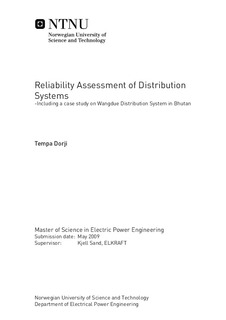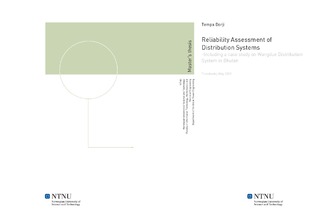| dc.contributor.advisor | Sand, Kjell | nb_NO |
| dc.contributor.author | Dorji, Tempa | nb_NO |
| dc.date.accessioned | 2014-12-19T13:51:16Z | |
| dc.date.available | 2014-12-19T13:51:16Z | |
| dc.date.created | 2010-09-04 | nb_NO |
| dc.date.issued | 2009 | nb_NO |
| dc.identifier | 348747 | nb_NO |
| dc.identifier | ntnudaim:4738 | nb_NO |
| dc.identifier.uri | http://hdl.handle.net/11250/256615 | |
| dc.description.abstract | A stable and reliable electric power supply system is an inevitable pre-requisite for the technological and economic growth of any nation. Due to this, utilities must strive and ensure that the customer s reliability requirements are met and the regulators requirements satisfied at the lowest possible cost. It is known fact around the world that 90% of the of the customer service interruptions are caused due to failure in distribution system. Therefore, it is worth considering reliability worth assessments as it provides an opportunity to incorporate the cost or losses incurred by the utilities customer as a result of power failure and this must be considered in planning and operating practices. The system modeling and simulation study is carried out on one of the district s distribution system which consists of 33kV and 11kV network in Bhutan. The reliability assessment is done on both 11 and 33kV system to assess the performance of the present system and also predictive reliability analysis for the future system considering load growth and system expansion. The alternative which gives low SAIDI, SAIFI and minimum breakeven costs are being assessed and considered. The reliability of 33kV system could be further improved by installation of load break switch, auto recloser and connecting with line coming from other district (reserve) at reasonable break even cost. The decision base could be further improved by having Bhutan s context interruption cost. However, the questionnaire s which may be used in Bhutan to acquire interruption costs from the customers are being proposed. The utility should have their own reliability improvement strategy depending upon their needs and requirements of the regulators. Although there is no magic bullet in managing power quality issues, utilities can maximize network performance and better serve customers by diligently addressing trouble prone areas. In order to achieve this objective, a computer program NetBas/Lesvik is used to run load flow and reliability analysis, thus selecting the alternatives either based on reliability indices or on cost benefit ratio. | nb_NO |
| dc.language | eng | nb_NO |
| dc.publisher | Institutt for elkraftteknikk | nb_NO |
| dc.subject | ntnudaim | no_NO |
| dc.subject | MSELPOWER Master of Science in Electric Power Engineering | no_NO |
| dc.subject | Elektrisk Energiteknikk | no_NO |
| dc.title | Reliability Assessment of Distribution Systems: -Including a case study on Wangdue Distribution System in Bhutan | nb_NO |
| dc.type | Master thesis | nb_NO |
| dc.source.pagenumber | 124 | nb_NO |
| dc.contributor.department | Norges teknisk-naturvitenskapelige universitet, Fakultet for informasjonsteknologi, matematikk og elektroteknikk, Institutt for elkraftteknikk | nb_NO |

